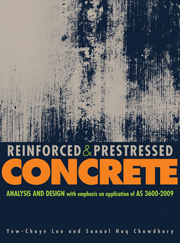Book contents
- Frontmatter
- Contents
- Preface
- Acknowledgements
- Notation
- Acknowledgements for tables and diagrams
- Acronyms and abbreviations
- Part I Reinforced concrete
- 1 Introduction
- 2 Design properties of materials
- 3 Ultimate strength analysis and design for bending
- 4 Deflection of beams and crack control
- 5 Ultimate strength design for shear
- 6 Ultimate strength design for torsion
- 7 Bond and stress development
- 8 Slabs
- 9 Columns
- 10 Walls
- 11 Footings, pile caps and retaining walls
- Part II Prestressed concrete
- Appendix A Elastic neutral axis
- Appendix B Critical shear perimeter
- Appendix C Development of an integrated package for design of reinforced concrete flat plates on personal computer
- Appendix D Strut-and-tie modelling of concrete structures
- Appendix E Australian Standard precast prestressed concrete bridge girder sections
- References
- Index
4 - Deflection of beams and crack control
from Part I - Reinforced concrete
- Frontmatter
- Contents
- Preface
- Acknowledgements
- Notation
- Acknowledgements for tables and diagrams
- Acronyms and abbreviations
- Part I Reinforced concrete
- 1 Introduction
- 2 Design properties of materials
- 3 Ultimate strength analysis and design for bending
- 4 Deflection of beams and crack control
- 5 Ultimate strength design for shear
- 6 Ultimate strength design for torsion
- 7 Bond and stress development
- 8 Slabs
- 9 Columns
- 10 Walls
- 11 Footings, pile caps and retaining walls
- Part II Prestressed concrete
- Appendix A Elastic neutral axis
- Appendix B Critical shear perimeter
- Appendix C Development of an integrated package for design of reinforced concrete flat plates on personal computer
- Appendix D Strut-and-tie modelling of concrete structures
- Appendix E Australian Standard precast prestressed concrete bridge girder sections
- References
- Index
Summary
General remarks
As discussed in Section 1.2, in addition to strength, durability and fire resistance, serviceability is a design requirement specified in AS 3600-2009 (the Standard). Practical recommendations are given in Clauses 8.5, 8.6 and 8.9 of the Standard, for the treatments of beam deflection, crack control and slenderness limits for beams, respectively. The Standard also touches very briefly on the vibration of beams, stating qualitatively in Clause 8.7 (and in Clause 9.5 for slabs), that ‘vibration of beams shall be considered and appropriate action taken where necessary to ensure that the vibrations induced by machinery, or vehicular or pedestrian traffic, will not adversely affect the serviceability of the structure’.
Although vibration topics are not dealt with in this book, the reader may refer to articles published by Chowdhury and Loo (2000, 2006), and by Salzmann et al (2003) for the damping characteristics of simple and continuous concrete beams.
In this chapter, details are provided on short and long-term deflection calculations, and on alternative design requirements of maximum span/effective depth ratio, in accordance with the Standard. The analysis of the total deflection of beams under repeated loading is also introduced as an advanced topic. For completeness, crack control of beams is discussed in some detail. All the deflection topics are supplemented by worked out examples. Recommendations for computing effective flange widths have been presented in Section 3.7.2. The reader is referred to the Standard for discussions on slenderness limits and vibrations.
- Type
- Chapter
- Information
- Reinforced and Prestressed ConcreteAnalysis and Design with Emphasis on Application of AS3600-2009, pp. 74 - 98Publisher: Cambridge University PressPrint publication year: 2010



